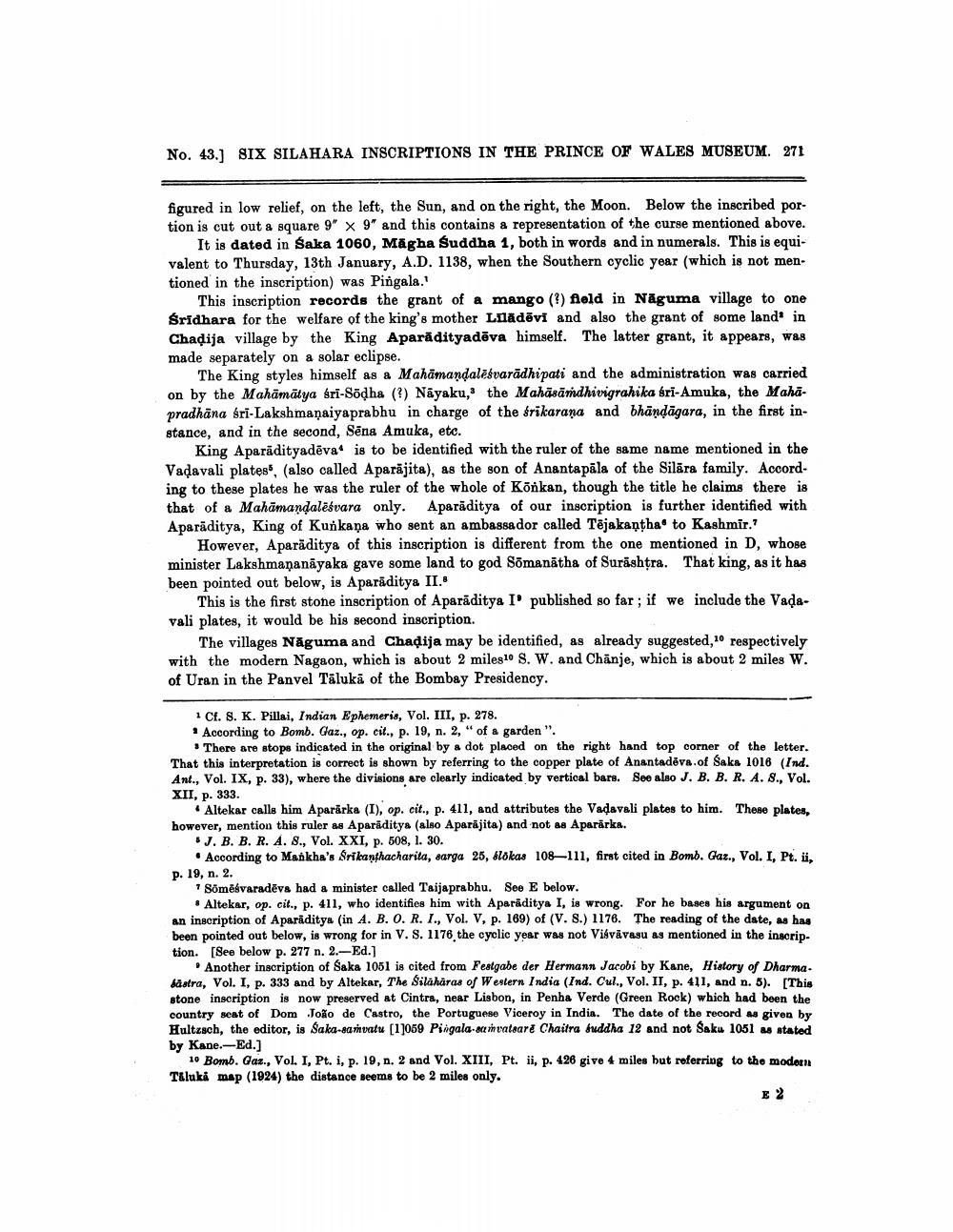________________
No. 43.] SIX SILAHARA INSCRIPTIONS IN THE PRINCE OF WALES MUSEUM. 271
figured in low relief, on the left, the Sun, and on the right, the Moon. Below the inscribed portion is cut out a square 9" x 9" and this contains a representation of the curse mentioned above.
It is dated in Saka 1060, Magha Suddha 1, both in words and in numerals. This is equivalent to Thursday, 13th January, A.D. 1138, when the Southern cyclic year (which is not mentioned in the inscription) was Pingala.'
This inscription records the grant of a mango (?) field in Naguma village to one Sridhara for the welfare of the king's mother Liladevi and also the grant of some land in Chadija village by the King Aparadityadeva himself. The latter grant, it appears, was made separately on a solar eclipse.
The King styles himself as a Mahamandalesvarādhipati and the administration was carried on by the Mahamatya śrī-Sōdha (?) Nayaku, the Mahasamdhivigrahika śrī-Amuka, the Mahāpradhana śri-Lakshmanaiyaprabhu in charge of the śrikarana and bhānḍāgara, in the first instance, and in the second, Sena Amuka, etc.
King Aparadityadeva is to be identified with the ruler of the same name mentioned in the Vadavali plates, (also called Aparajita), as the son of Anantapala of the Silära family. According to these plates he was the ruler of the whole of Konkan, though the title he claims there is that of a Mahamandalesvara only. Aparaditya of our inscription is further identified with Aparaditya, King of Kunkana who sent an ambassador called Tejakantha to Kashmir."
However, Aparaditya of this inscription is different from the one mentioned in D, whose minister Lakshmananayaka gave some land to god Sōmanatha of Surashtra. That king, as it has been pointed out below, is Aparäditya II."
This is the first stone inscription of Aparaditya I published so far; if we include the Vadavali plates, it would be his second inscription.
The villages Naguma and Chaḍija may be identified, as already suggested,10 respectively with the modern Nagaon, which is about 2 miles10 S. W. and Chanje, which is about 2 miles W. of Uran in the Panvel Taluka of the Bombay Presidency.
1 Cf. S. K. Pillai, Indian Ephemeris, Vol. III, p. 278.
According to Bomb. Gaz., op. cit., p. 19, n. 2, " of a garden".
There are stops indicated in the original by a dot placed on the right hand top corner of the letter. That this interpretation is correct is shown by referring to the copper plate of Anantadeva.of Saka 1016 (Ind. Ant., Vol. IX, p. 33), where the divisions are clearly indicated by vertical bars. See also J. B. B. R. A. 8., Vol. XII, p. 333.
Altekar calls him Apararka (I), op. cit., p. 411, and attributes the Vadavali plates to him. These plates, however, mention this ruler as Aparaditya (also Aparajita) and not as Apararka.
J. B. B. R. A. 8., Vol. XXI, p. 508, 1. 30.
• According to Mankha's Srikanthacharita, sarga 25, élõkas 108-111, first cited in Bomb. Gaz., Vol. I, Pt. ii, p. 19, n. 2.
1 Sōmēsvaradeva had a minister called Taijaprabhu. See E below. Altekar, op. cit., p. 411, who identifies him with Aparaditya I, is wrong. For he bases his argument on an inscription of Aparaditya (in A. B. O. R. I., Vol. V, p. 169) of (V. S.) 1176. The reading of the date, as has been pointed out below, is wrong for in V. S. 1176, the cyclic year was not Viśvāvasu as mentioned in the inscription. [See below p. 277 n. 2.-Ed.]
Another inscription of Saka 1051 is cited from Festgabe der Hermann Jacobi by Kane, History of Dharmabastra, Vol. I, p. 333 and by Altekar, The Silähäras of Western India (Ind. Cul., Vol. II, p. 411, and n. 5). [This stone inscription is now preserved at Cintra, near Lisbon, in Penha Verde (Green Rock) which had been the country seat of Dom João de Castro, the Portuguese Viceroy in India. The date of the record as given by Hultzsch, the editor, is Saka-samvatu [1]059 Pingala-samvatsare Chaitra buddha 12 and not Saku 1051 as stated by Kane.-Ed.]
10 Bomb. Gaz., Vol. I, Pt. i, p. 19, n. 2 and Vol. XIII, Pt. ii, p. 426 give 4 miles but referring to the modern Taluka map (1924) the distance seems to be 2 miles only.
E 2




